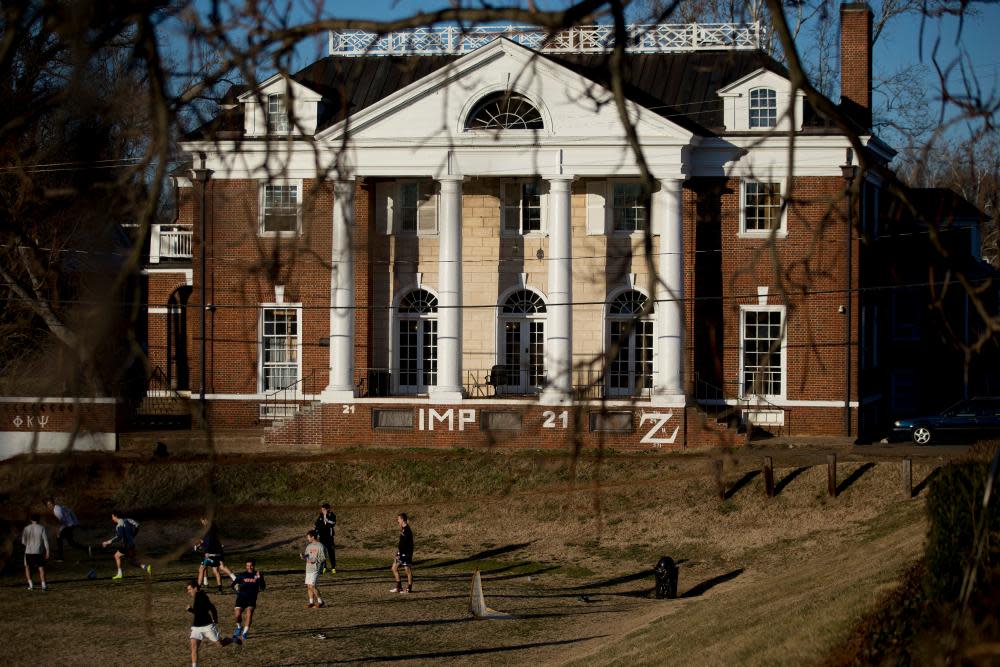Five years on, the lessons from the Rolling Stone rape story

Five years ago, when Sabrina Rubin Erdely’s “A Rape on Campus” article first appeared, the bombshell story ignited a conversation about sexual violence on college campuses.
First published in Rolling Stone in November 2014, the roughly 9,000-word feature story described a student called Jackie’s experience at her first fraternity party at the University of Virginia – and specifically, her account of how she was brutally gang-raped by seven men while other fraternity brothers looked on.
In the story Jackie was pushed through a low-lying glass table and pinned to the ground amid shards of glass. “‘Grab its motherfucking leg,’ she heard a voice say. And that’s when Jackie knew she was going to be raped.” At one point a fraternity brother shoves a beer bottle into her as others cheer. Afterwards Jackie stumbled away from the frat house barefoot and bleeding in the middle of the night, and called several friends for support only to have them raise concerns about the “social price” of Jackie reporting her rape.
But cracks soon surfaced in the story. Erdely hadn’t factchecked her central source, and Jackie’s claims were not borne out by subsequent reporting. “We have come to the conclusion that our trust in her was misplaced,” Rolling Stone wrote of Jackie, before ultimately retracting the story.
Now five years later, in the aftermath of #Metoo, what was its legacy really?
In a way the story presaged a wave of high-profile dedication to sexual assault reporting across news organizations, as well as attacks from many – including the president and his supporters – that the media are an enemy who can’t be trusted.
The story’s trail of destruction was also significant for the people directly involved. Rolling Stone faced years in the courts, paying out millions to those who suffered reputational damage – losses which may have contributed to the sale of the magazine in 2017 amid other financial strains.
Erdely’s public life, as embodied by her Twitter account, still seems frozen, a perfect time capsule of the moment right before everything came down around her. (Her last tweet, on 30 November 2014, is a Washington Post profile of her looking at how the UVA story came to be.)
Shortly thereafter, the story of Rolling Stone’s reporting failure would eclipse the larger problem of the systematic abuse and mistreatment of women across college fraternities and beyond – even as it would help inspire a new commitment to tenacious sexual assault reporting down the road.
Not that anyone would have predicted that at the time of publication.
When it first came out, the Rolling Stone piece sparked protests at UVA, and the school announced the suspension of all college Greek life. Nationally there were petitions, op-ed columns, cable news conversations and tweets from politicians and celebrities, calling out fraternity culture.
It’s easy to see why so many reacted so strongly early on.
Erdely’s writing was almost devoid of the journalistic qualifiers like “allegedly”, leaving the reader with the impression the events described were undisputed facts. The dialogue was sensational – it read like something from a movie.
In early interviews, Erdely declined to say what she knew about Jackie’s alleged attackers or if she’d reached out to the man at the center of the story for comment. Her cinematic writing style had obscured that she was telling a largely single-source story, and it would later be revealed her source had fabricated virtually the entire thing.
There was no party at the fraternity in question at the time described, and no student who fit the descriptions of the alleged ringleader of the attack. Jackie had called up friends on the night in question, but the account she had given them didn’t match what she’d told Rolling Stone.
But the culture wasn’t primed to look for such inconsistencies.

The years leading up to the publication of the Rolling Stone story had been a period of growth for sexual assault reform. The title IX civil rights law governing equity in college athletics had expanded to include cases of harassment and sexual assault, and the media were taking the topic more seriously.
In 2012 there was blanket coverage of the Jerry Sandusky trial, the assistant football coach at Penn State convicted of rape and child sexual abuse. In 2013, two high school football players were found guilty of raping a 16-year-old girl in Steubenville, Ohio, following global attention to the case. And in 2014 – the same year the Rolling Stone piece was published – Columbia undergraduate Emma Sulkowicz received national attention for carrying her mattress around campus after the school declined to take action against her alleged rapist.
Such a climate gave rise to a new heightened journalistic awareness around the need to be respectful and not retraumatize a source. But such considerations may have tipped Erdely toward being overly deferential.
As the holes in her reporting were revealed, conservative backlash took root. The Federalist ran a story entitled, “Leftist Media Show How Not To Defend Rolling Stone UVA Rape Story”. The Daily Caller ran no fewer than 16 stories on what it termed the “UVA rape hoax”.
Last year, during the confirmation hearings of supreme court justice Brett Kavanaugh, the Rolling Stone story was still being held up as a reason not to believe women. “I’m not saying #ChristineBlaseyFord is lying, but to those parroting the inane ‘What woman would lie about #SexualAssault?’ – line … Google any of these,” one person tweeted, before listing Jackie’s name in hashtag form. Another named Jackie as a reason to question Democrats who believe women’s stories of abuse at all.
Within the world of journalism, the UVA story has been instructive as a cautionary tale.
“There was concern from some corners that showing the flaws in reporting would discourage victims from speaking to journalists,” said Sheila Coronel, academic dean of Columbia University’s Graduate School of Journalism and the lead author of the postmortem report on the story put out by the Columbia Journalism Review.
Since then, Coronel told the Guardian, “I think we’ve seen much more rigorous reporting on sexual assault. We’ve seen a lot of very persistent and admirable attempts to corroborate the accounts of women.”
Chief examples include reporting on Bill Cosby, as well as Pulitzer prize-winning investigations into Harvey Weinstein. And She Said – the book by Jodi Kantor and Megan Twohey on reporting out the Weinstein story for the New York Times – helped crystalize reporting lessons.
But Coronel also noted that Erdely and her editors’ mistakes should not be allowed to eclipse the larger problems the flawed story sought to illuminate. That also seemed to be a takeaway from an essay by Jia Tolentino in her debut book, Trick Mirror.
In it, Tolentino – a UVA alum – seems to echo Coronel’s point, delving into the nuances of what was, in fact, a pervasive and pernicious culture around sexual assault on campus, and one with a long history.
Thirty years earlier, UVA student Liz Seccuro had been brutally gang-raped at Phi Psi. But when she finally brought her rapist to trial while Tolentino was still in school, Tolentino recalled little public reaction.
Tolentino was among those convinced something happened to Jackie. Though the details of Jackie’s account weren’t accurate or reportable, perhaps, Tolentino reasoned, alterations she’d made in the truth felt consistent with some level of injury she’d endured.
That might read like conjecture but the interpretation resonates with the experience of Tracy Tamborra, a professor of criminal justice at the University of New Haven, who also worked for years as a director of a domestic violence services agency in New Jersey.
Tamborra recalled to the Guardian how once, after a week of working with a client – a 19-year-old who’d landed in the hospital having been visibly physically assaulted – she had sensed something was wrong with the story. After a frank conversation, the teenager admitted to having changed a key detail: she’d been raped not by a neighbor, but by her stepfather.
“The issue wasn’t that she wasn’t raped, it’s that the details of the rape were too painful to recount at the time of the exact moment of the investigation,” Tamborra said. Nevertheless, after that, the police were reluctant to deal with the teenager, given the false report on her record.
“I don’t think it’s the norm, but I do have a couple of stories like that,” Tamborra said of victims whose narratives evolve.
The scholarly work of Rebecca Campbell about memory recall at the point of trauma, further supports the observation.
Victims very often can’t recall specific information, according to Campbell, a professor of psychology at Michigan State University who studies sexual assault. Or they misremember things initially because of the way trauma affects the brain. In some cases, aspects of the story are so humiliating that stories are altered to fit a narrative that’s more palatable either to the victim, a third party involved or the investigator.
One bright spot of the cultural change though, is that the media, and in turn survivors themselves, are increasingly recognizing these complexities – as well as the spectrum of what constitutes sexual assault.
That’s according to Shana L Maier, a professor in Widener University’s department of criminal justice whose research focuses on sexual assault and rape reporting.
“The strength is awareness,” Maier told the Guardian, “encouraging victims to reach out for help and support and bringing awareness to the continuum of sexual violence. Victims thought it had to be the myth – the stranger jumping out of the bushes. And one of the benefits of the #MeToo movement is getting awareness out that there’s a broad continuum for victimization.”
Not all of it is reportable.

